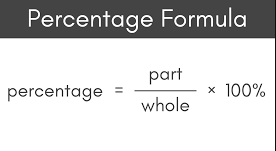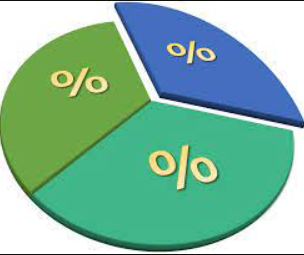Simplify your percentage calculations with our easy-to-use Percentage Calculator. It helps you quickly figure out percentages for any purpose, making math tasks straightforward and accurate.
Calculating percentage change can leave many people wondering where to start. It’s a fundamental concept that allows us to measure growth or decline across various aspects of life and work.
This guide will guide you through the process of finding percent changes with ease, using both straightforward explanations and practical examples. Discover the simplicity behind this important mathematical operation and get ready to apply it confidently in your own scenarios.
Understanding Percent Change
Grasping the concept of percent change is foundational for interpreting the dynamic shifts that occur in various numerical contexts. It serves as a mathematical measurement reflecting the degree to which a value has grown or diminished, providing insights into trends and magnitudes that are vital across numerous applications.
Definition of percent change
Percent change is a way to show how much something has gone up or down over time as part of the first amount. It tells you by what percentage the original number has increased or decreased.
To figure out percent change, you find the difference between two numbers, divide it by the starting value, and then turn that into a percentage.
To do this, use the formula: ((new number – original number) / original number) * 100. If your answer is positive, it means there was an increase; if negative, there’s been a decrease.
Percent changes make it easier to see growth or decline in things like prices, sales, and populations without having to talk about exact numbers all the time.
To understand how much something has grown or shrunk, there’s a simple math tool we can use. It’s called the percent change formula. Think of it like a detective who helps you spot the difference between two numbers and tells you by what percentage one number is bigger or smaller than the other.
Here’s what you do: Take the new number and subtract the original number from it. If this sounds tricky, picture having 10 apples last week and now you have 15. You gained 5 apples! Now divide those extra apples by your first amount (which was 10).
Last step – to turn this into a percentage, just multiply your answer by 100. So in our Apple example, that would show us that we got a big increase of 50%. This works whether numbers go up or down, so if prices drop or scores improve, this formula will tell you exactly how much they changed! Convert fractions to percentages effortlessly using our Fraction to Percent Calculator.
How to Find Percent Change
Calculating percent change is a valuable skill, whether you’re tracking stock price movements, analyzing business earnings over time, or comparing statistics in a report. Our step-by-step guide will equip you with the knowledge to confidently determine the relative difference between two values and understand the implications of these changes within various contexts.
Step-by-step guide for calculating percent change
Finding the percent change helps us understand how much something has increased or decreased. It’s a simple way to see growth or decline over time. Here’s how you do it:
- Start with two numbers: the initial value and the final value.
- Subtract the initial value from the final value to find the difference.
- Divide this difference by the absolute value of the initial number.
- Multiply the result by 100 to get a percentage.
- This percentage shows your increase if it’s positive, or decrease if it’s negative.
- Say you have $50 at first (the initial value).
- Later, you end up with $75 (the final value).
- You’d subtract 50 from 75, giving you a difference of 25.
- Next, divide that 25 by 50 to get 0.5.
- Finally, multiply 0.5 by 100 to reach your answer: a 50% increase.
Real-life examples
Gas prices went up 10% last year. If you filled your tank for $30 before, now it costs $33. This is how percentage increase affects your wallet every day. A store might lower the price of a shirt by 15%.
If the shirt was $20, now it’s only $17. People get to save money when things cost less.
Businesses use these changes too. Imagine a company’s stock drops 15%. Investors need to think about what this means for their money. Now look at a restaurant that starts using a new menu and makes 20% more sales.
They see how changing just one thing can really help them earn more money.
Now let’s talk about personal budgets and choices. Say someone switches phone plans and spends 5% less each month. Even small savings like this can add up over time—more dollars stay in their pocket! Students sometimes improve grades by 10% with tutoring; hard work plus help can lead to better results.
These are all ways people see percentages in daily life – from shopping to investing, learning to saving cash.
Let’s move into how percent changes play a huge role in business and finance next. Also easily calculate percentage decrease with our user-friendly Percentage Decrease Calculator.
Percentage Conversion Table
| Percentage | Decimal | Fraction |
|---|---|---|
| 1% | 0.01 | 1/100 |
| 5% | 0.05 | 1/20 |
| 10% | 0.10 | 1/10 |
| 25% | 0.25 | 1/4 |
| 50% | 0.50 | 1/2 |
| 75% | 0.75 | 3/4 |
| 100% | 1.00 | 1/1 |
Practical Applications of Percent Change
Understanding percent change is not just a mathematical exercise; it’s a tool that empowers professionals across various fields. From assessing growth rates in business to analyzing inflation trends in economics, the ability to calculate percentage increases or decreases equips individuals with crucial insights for strategic decision-making.
Business and Finance
In business and finance, percent change is a key tool. It helps people see how things like sales and expenses grow or shrink over time. For example, a company might look at the percent increase in sales from one year to the next to find out if they are doing better.
Investors also use percent change to check on their stocks or bonds. They can see if the value has gone up or down by looking at the percentage.
With these numbers, companies can plan their budgets better and guess what will happen in the future. Percent change lets them manage risks too. Knowing how much something changes is powerful—it guides decisions that could lead to making more money or stopping losses before they get big.
Economics
Percent change plays a big role in economics. It tells us how much something has grown or shrunk, like the inflation rate or demand for products. Economists use percentage increases and decreases to understand markets better.
For example, if you hear that the price of apples has risen by 5% since last year, that’s a percent change at work.
Understanding these changes helps businesses and governments make smart choices. They might adjust prices, buy more supplies, or create new rules to help the economy stay strong. Using a percent change calculator can show quick math results, so people can decide what to do next with more confidence.
Data analysis
In data analysis, finding percent change is key. It helps you see how things grow or shrink over time, like sales numbers, stock prices, or even test scores. You use the percent change formula to figure out these differences.
For example, a business can check if its earnings went up or down by comparing last year’s profit to this year’s.
Understanding percent changes also matters in science and health fields. Experts might look at how much a disease spreads in one year compared to another. They calculate percentage increases or decreases to understand the situation better.
Next, let’s explore how all of this applies in everyday life with practical examples!
FAQs
1. How do I calculate percent error?
To figure out the percent error, you compare what you expected to what really happened, do some math with those numbers, and then multiply by 100 to get a percentage.
2. What does delta mean when talking about percentages?
Delta means ‘change’ in math terms. So when we talk about delta in percentages, we are looking at how much something changed from before.
3. Why would someone need to know their basal metabolic rate as a percentage?
Knowing your basal metabolic rate (BMR) helps understand how many calories your body needs if it is resting all day. Some calculators like the Harris-Benedict equation might turn this into a percent by comparing it with other factors such as exercise level.
4. How can fractions be converted into percentages using calculators?
To change fractions into percentages with calculators, first make them into decimals by dividing the top number (numerator) by the bottom one (denominator), and then multiply that decimal by 100.
Related Calculators:


